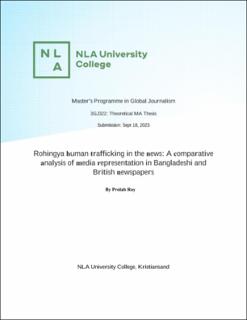| dc.description.abstract | Human trafficking has emerged as one of the fastest-growing criminal activities, impacting almost every single nation in the world. This study examines and compares the way in which human trafficking of Rohingya refugees was presented in a Bangladeshi and a British newspaper between 2017 and 2021. Rohingya refugees, an ethnic Muslim minority, have become vulnerable to human trafficking following the military crackdown in Myanmar’s Rakhine state in 2017. The current study employs a quantitative content analysis of 71 news articles from the Daily Star (BD) and the Guardian (UK) over a five-year period. A comparative analysis of media coverage of the Rohingya trafficking issue identifies major similarities and differences in the way the issue is framed, sources, and news tones used in these two countries. The study finds that six different frames, ten various sources, and three news tones are used to describe the Rohingya trafficking issue. For example, the Bangladeshi newspaper predominantly used the criminal justice frame, while the British newspaper used the victimization frame. Conversely, the health risk frame is the least prominent in the Bangladeshi newspaper while the criminal justice frame and human business frames are both considered less important in the British newspaper. While the Bangladeshi media uses the law enforcer’s source with top importance, the British newspaper suggests the predominant use of aid/NGO/human rights groups’ sources. However, both newspapers use official sources with great similarities. In terms of news writing tone, both media outlets predominantly utilize positive tones towards the refugees and trafficking victims. The Bangladeshi newspaper also presents the Rohingya refugees and trafficking victims negatively, marking the second most prominent tone within its articles. However, the British newspaper did not contain any negative tone in its coverage.
Keywords: Human Trafficking, Rohingya Human Trafficking, Rohingya Refugee, Rohingya Trafficking, Rohingya Crisis, Media Framing, Media Representation, Framing Analysis, Comparative Analysis, Bangladesh, United Kingdom. | en_US |
